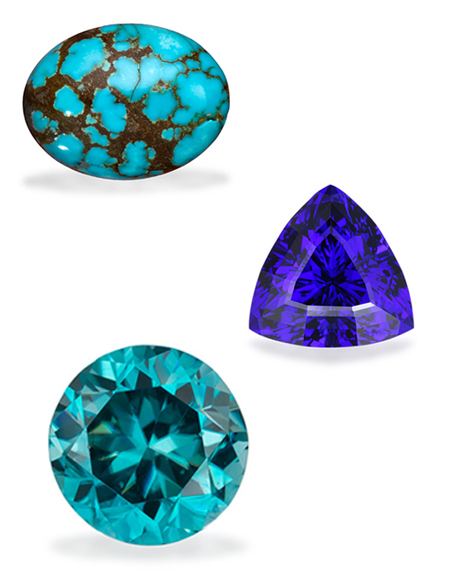
Turquoise, Tanzanite & Zircon
If you had to pick one December birthstone, which would it be: tanzanite, turquoise or zircon? From the blue to bluish purple of tanzanite, to the intense blue and green of turquoise, to the rainbow varieties of zircon – there’s a color for everyone. If blue is what you’re looking for, all three December birthstones have their own unique take on this favourite hue. Whatever your color, style or budget preferences may be, we can help you pick the right December birthstone for you or a loved one.
Turquoise, Tanzanite & Zircon Stone Facts
Turquoise is a semi-translucent to opaque gem that ranges from blue to green and often has veins of matrix (remnants of the rock in which it formed) running through it. This December birthstone has been cherished for millennia.
The turquoise birthstone was thought to possess many beneficial powers, like guaranteeing health and good fortune.
Some turquoise is treated to improve its durability (it has a Mohs hardness of 5 to 6), appearance and polish. Turquoise can be dyed or chemically enhanced by adding an epoxy or acrylic resin for greater hardness or better color. Also seen are cavities filled with a metal-loaded epoxy to imitate pyrite inclusions.
Turquoise is generally stable to light, but high heat can cause discoloration and breakage. Your turquoise birthstone can be damaged by acids, and it can be discoloured by certain chemicals, cosmetics and even skin oils or perspiration. It’s safe to clean turquoise jewelry with warm, soapy water, but this December birthstone should never be cleaned with steam or ultrasonic cleaners. Heat or solvents can damage the treated surfaces on some turquoise.
Tanzanite:
Tanzanite may be a relative newcomer to the world of colored stones, but it was one of the most exciting gem discoveries of the 20th century. Blue stones emerging from Tanzania were identified as the mineral zoisite in 1962. Not until 1967, though, did prospectors locate the primary source for this December birthstone: the Merelani Hills. It was eventually named tanzanite in honor of its country of origin. The tanzanite birthstone is often described as “velvety,” mostly because of its deep and saturated color, which ranges from a pure rich blue to violet, with the blue considered most valuable.
This December birthstone (6 to 7 on the Mohs scale of harness) is resistant to the effects of normal heat, light and common chemicals. Still, the December birthstone may crack if exposed to very high temperatures or sudden temperature changes, and it abrades easily. It can be attacked by hydrochloric and hydrofluoric acids.
Most tanzanite begins as brownish zoisite that is heat treated to produce the blue to violet hues that characterize this December birthstones. The resulting color is permanent, and there are no additional durability concerns.
Your tanzanite birthstone is best set in earrings or pendants. While not recommended for daily wear in a ring, with a protective mounting and some care this December birthstone can be an attractive special-occasion jewel.
Warm, soapy water is the best way to clean this December birthstone. Ultrasonic and steam cleaners are never recommended for tanzanite.
ZIRCON:
The origins of the word “zircon” have elicited colourful debate. Some scholars believe it comes from the Arabic word zarkun, meaning “cinnabar” or “vermilion.” Others think the source is the Persian word zargun, or “gold colored.” Considering the broad color palette for this December birthstone – red, orange, yellow, brown, green and blue – either derivation seems possible. Colorless zircon is known for its brilliance and flashes of multi-coloured light, called fire, which have resulted in centuries of confusion with diamond.
Zircon ranges from 6 to 7.5 on the Mohs scale of hardness. It is commonly heat treated to produce blue and colorless varieties, as well as orange, yellow and red. The gem is generally stable when exposed to light, but some heat-treated stones may revert to their original colors (usually light brown) after prolonged exposure to bright light. Exposure to heat can alter the color of some zircon. This December birthstone is stable when exposed to chemicals.
Because zircon tends to abrade, it is best to avoid wearing it in rough conditions, such as while gardening, playing sports or doing dishes.
Clean your zircon using a soft brush and mild soap in warm water. Ultrasonic and steam cleaners are not recommended for this December birthstone.
